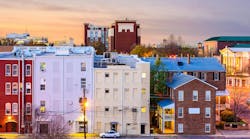Initiating Conservation
In an effort to help educate the public about storm water management and water conservation practices for the area, the city of Grand Rapids, Mich., has partnered with various nonprofit environmental groups, including the West Michigan Environmental Action Council (WMEAC). Storm Water Solutions Editorial Director Neda Simeonova discussed these efforts with City of Grand Rapids Wastewater Treatment Plant Laboratory Chemist Sandy Buchner.
Neda Simeonova: Why do water conservation and reuse practices play such an important role in storm water management for U.S. communities?
Sandy Buchner: Communities compete for resources, and the competition continues to heat up. If communities want to be fiscally fit, they need to find sources of funding. This is easier done when there are positive things happening because people want to live in a community that makes efforts to improve the quality of life for its residents while protecting the environment. Water conservation and reuse seems like a very obvious place for a community to start making a difference.
Everywhere we turn there is some environmental issue in the news. Locally, a beach closure on Lake Michigan because of high E. coli results is likely due to recent heavy rains. The heavy rains also have caused flooding and road washouts in Michigan’s southern lower peninsula, and they are expected to have a negative effect on crops this season. Of course on a national level, there is the ongoing oil leak in the Gulf.
There is so much going on that is having a negative effect on our environment, and we seem to have little to no control. Water reuse and conservation, however, are things we can do on an individual as well as community level.
Simeonova: What partnerships has the city of Grand Rapids developed to implement these initiatives?
Buchner: Many city departments have made efforts to reduce water use. The city’s wastewater treatment plant reuses treated wastewater for cleaning tanks and maintaining the grounds, including irrigation. The city conserves water by sealing large-diameter transmission mains and educating the public on water conservation and requirements for landscaping plans that reduce water use. Since 2000, the city has conserved about 8.5 billion gal of water.
As a part of our community-based storm water program, Grand Rapids has partnered with WMEAC to hold rain barrel workshops, which offer free rain barrels for city residents, as well as a number of rain garden projects. The River of Stars Rain Garden was the city’s first rain garden and WMEAC’s first demonstration garden. Since its installation in 2002, there have been a number of other rain gardens planted and many visitors. The gardens are a part of our community storm water education program.
The city also provides WMEAC with a nursery location to propagate native plants throughout the region to be used in public education and managing storm water. There are a number of bioswales, rain gardens and green roofs built or under construction. Grand Rapids also participates in the Watershed Management Plan of the Lower Grand River Organization of Watersheds.
Simeonova: How does Grand Rapids get the community involved to support these programs?
Buchner: There has been a lot of positive press surrounding our initiatives to protect natural resources and the environment. The United Nations recognized Grand Rapids as a Sustainability Center of Expertise. The 2010 Siemens Sustainable Community Award recognized Grand Rapids as the most sustainable midsized city, and the Great Lakes St. Lawrence Cities Initiative recognized us for water conservation progress.
The positive press encourages participation. Community-based planning is a big part of that success. A series of meetings is used to engage citizens in updating The Grand Rapids Master Plan, with seven interrelated themes: great neighborhoods, vital business districts, a strong economy, balanced transportation, a city that enriches our lives, a city in balance with nature and partnerships. A citywide green infrastructure master planning process known as Green Grand Rapids was very successful in engaging the public.
The above-mentioned themes were developed based on the involvement of some 3,000 Grand Rapidians in more than 250 community meetings. Ongoing meetings for a community-based storm water plan include discussions on promoting construction of rain barrels, bioswales and rain gardens.
Download: Here

